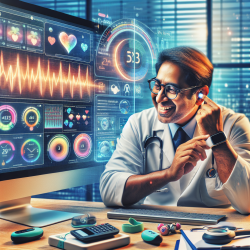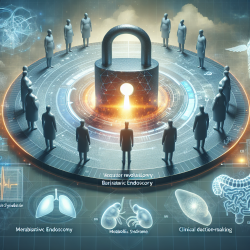Fun and Easy Reading: Enhancing Practitioner Skills with Remote Monitoring Technologies

In the ever-evolving landscape of healthcare, integrating advanced technologies such as sensors, wearables, and remote patient monitoring (RPM) into clinical practice can significantly enhance patient outcomes. A recent scoping review titled "Sensor, Wearable, and Remote Patient Monitoring Competencies for Clinical Care and Training: Scoping Review" provides a comprehensive analysis of the competencies required for effective implementation of these technologies in clinical settings. This blog will explore how practitioners can improve their skills by incorporating the findings of this research into their practice.
Understanding the Competencies
The scoping review identifies essential competencies across various learner levels—novice, competent, and expert. These competencies ensure that healthcare providers can effectively use sensors, wearables, and RPM technologies to improve patient care. The key competencies include:
- Patient Assessment and Evaluation: Understanding how to gather information using these technologies to develop accurate diagnoses and treatment plans.
- Engagement and Interpersonal Skills: Communicating effectively with patients about the use of technology and its impact on their care.
- Management and Treatment Planning: Integrating technology into treatment plans and monitoring its effectiveness.
- Administration and Medico-Legal Issues: Ensuring compliance with legal and ethical standards related to data privacy and security.
- Decision-Making and Information Systems: Utilizing clinical decision support systems to interpret data and make informed decisions.
Implementing the Competencies
To effectively implement these competencies, practitioners should follow a structured approach:
- Assess Readiness: Evaluate your current knowledge and skills related to RPM technologies.
- Seek Training: Participate in training programs and workshops that focus on the identified competencies.
- Apply Knowledge: Start incorporating these technologies into your practice, beginning with simple applications and gradually moving to more complex ones.
- Evaluate Outcomes: Continuously monitor the impact of these technologies on patient outcomes and make necessary adjustments.
- Collaborate: Work with other healthcare providers, IT specialists, and administrators to ensure a seamless integration of these technologies into your practice.
Encouraging Further Research
While the scoping review provides a solid foundation, further research is essential to keep up with the rapidly advancing field of healthcare technology. Practitioners are encouraged to:
- Stay Updated: Regularly review the latest research and advancements in RPM technologies.
- Participate in Studies: Engage in clinical studies and trials to contribute to the growing body of knowledge.
- Share Findings: Disseminate your experiences and findings through professional networks and publications.
Conclusion
Integrating sensors, wearables, and RPM technologies into clinical practice can significantly enhance patient care. By focusing on the identified competencies and encouraging further research, practitioners can stay at the forefront of healthcare innovation.To read the original research paper, please follow this link:
Sensor, Wearable, and Remote Patient Monitoring Competencies for Clinical Care and Training: Scoping Review.
Citation: Hilty, D. M., Armstrong, C. M., Edwards-Stewart, A., Gentry, M. T., Luxton, D. D., & Krupinski, E. A. (2021). Sensor, wearable, and remote patient monitoring competencies for clinical care and training: Scoping review. Journal of Technology in Behavioral Science, 6(2), 252-277. https://doi.org/10.1007/s41347-020-00190-3










